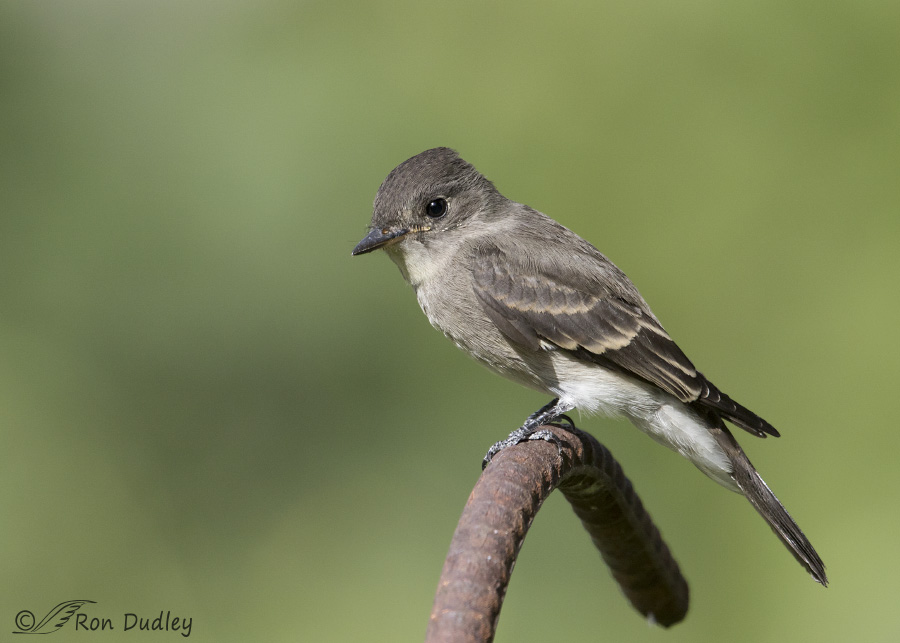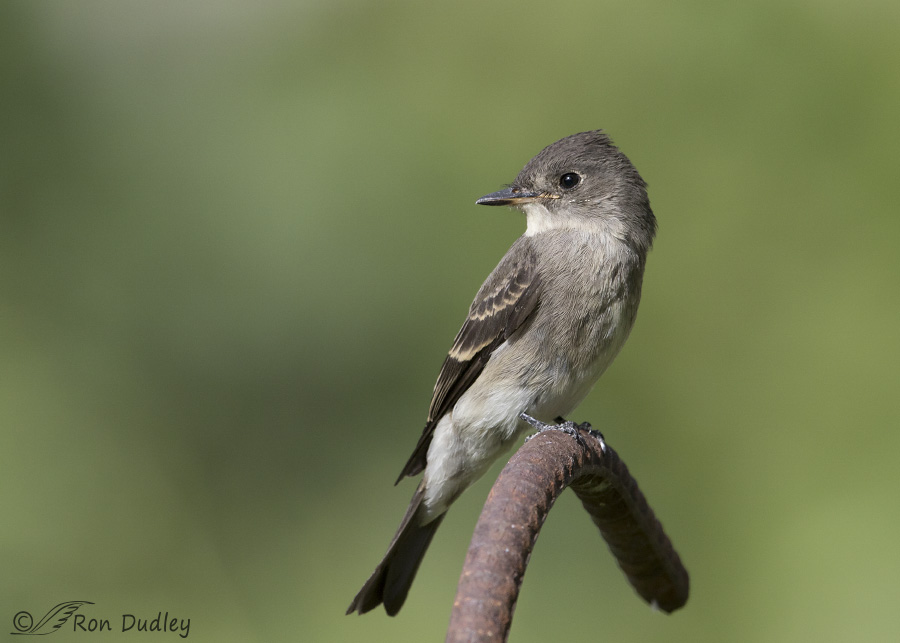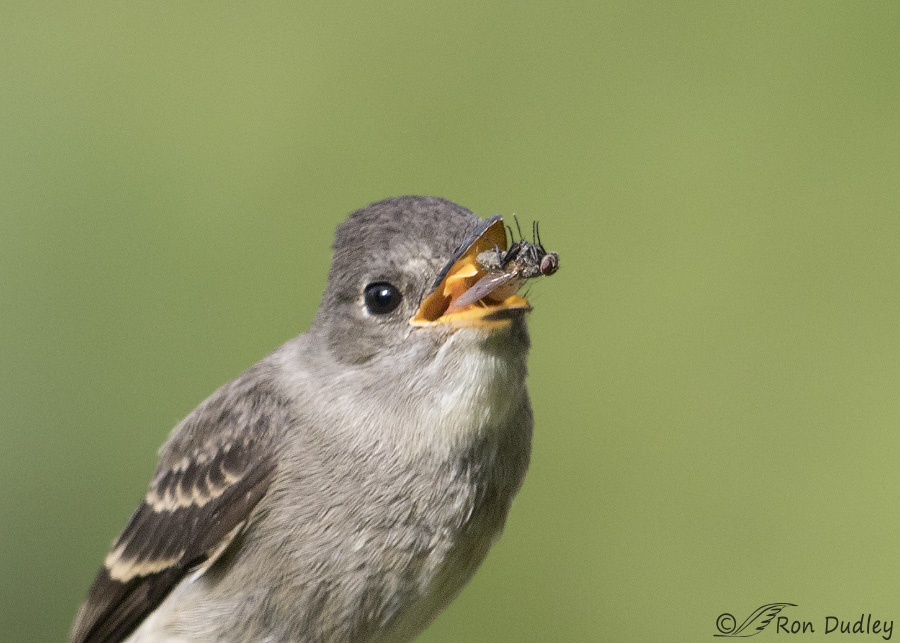This unusual visitor to my yard nearly caused me to be late publishing my blog post two mornings ago. My evening schedule is usually pretty inflexible – typically I sit down at my computer at 5 pm and spend the next several hours deciding the subject of the next morning’s post, working up images for that post and beginning to compose it.
But this flycatcher disrupted my schedule.

1/2500, f/6.3, ISO 640, Canon 7D Mark II, Canon EF 500mm f/4L IS II USM + 1.4 tc, not baited, set up or called in
Right at 5 pm I looked out my kitchen window and spotted the flycatcher hawking insects in my back yard. It was using this bent piece of rusty rebar to launch from and it nearly always returned to it prior to its next flight. It was close to my patio door so I quickly grabbed my gear and fired off quite a few shots through the dirty glass but for obvious reasons those images were soft so I took the chance that I’d scare the bird off and opened the door. The flycatcher stuck.
I’m not particularly fond of the perch so I spent most of my time trying to photograph the bird in flight just prior to landing. Those are tough shots to get and I struck out in that regard but flycatchers aren’t an everyday subject for me so I decided to post a few shots of it anyway, unattractive perch or not.

1/2500, f/6.3, ISO 640, Canon 7D Mark II, Canon EF 500mm f/4L IS II USM + 1.4 tc, not baited, set up or called in
Part of the reason I chose to go with it is because I’d like a little help with the ID. Empidonax flycatchers are notoriously difficult to identify even for experts and I’m far from an authority on them. There’s been some speculation that it could be a Willow Flycatcher but I have no confidence in that tentative ID so if anyone has any thoughts on the subject I’d appreciate hearing them.

The flycatcher was a ferocious and highly successful hunter. Most of its insect forays were successful and at least twice its victims were house flies which elevates this little bird to hero status in my book. This image is a huge crop and the prey is about the only thing in the photo that’s sharp but I hate house flies so much I enjoy seeing this one with its legs sticking up in its death throes. House flies are so sticky and annoying this time of year that this image gives me some sadistic satisfaction.
Anyway, I spent enough time with this bird instead of working on my Turkey Vulture post of two days ago that the post almost didn’t get published. The pressure was worth it though, especially for a bird that I seldom get to photograph and one who is responsible for the demise of so many of those damned flies.
Ron
Note: In case it may be helpful for ID purposes I photographed this bird in the suburbs of Salt Lake City but there’s riparian habitat (the Jordan River) nearby.


Long live the flycatcher. Send them to my house. They can live inside!
This little guy was definitely worth interrupting your schedule for. I, too, appreciate that they catch the flies I hate so much.
I love this post and your photos are so beautiful! Thanks for the great post.
Hi Ron, I agree with those who feel that this is a Western Wood-pewee. The raised peak at the back of the head, partially darker lower mandible and dark spots on under-tail coverts. Juvenile, due the lighter gape and buffy wing-bars. I get a few here on the Central California Coast, during fall migration, although for the past two years they have been scarce, most likely due to the severe drought. Good to see yours with plenty of food, especially for a youngster. I would have been disappointed if you hadn’t posted these excellent photos due to the rebar. Our drought is so bad that we had very few flies or mosquitoes.
Wow! Incredible photos!!!
Such a cute bird. The bird feathers blend in with the perch, and give it a “natural” feel. Wonderful pic of the doomed fly.
Thanks, Jean. I guess they’re called flycatchers for good reason!
The overwhelming consensus, both here and on a Facebook bird ID group, is that this bird is a Western Wood Peewee so at this point I’m going with that. Thanks very much to all who commented and provided feedback!
I would agree with Brian and Neil, A Western Wood-Pewee, probably a juvenile. An adult Western Wood-Pewee would have less buffy wingbars. Long wings/primary projection, weak eye ring and dark on most of the lower mandible help to confirm this. Primary projection is too long for a Grey Flycatcher and the color of the lower mandible would eliminate a Willow. Great shots Ron !!
Thanks very much for the feedback, Tjie.
The only sort of mighty hunter I will applaud. No trophies, just food. And a fly less is a winner here.
“And a fly less is a winner here”
Isn’t that the truth, EC!
Ron,
My first impression was juvenile Western Wood-pewee based on head shape and the color of its breast among other things. I’ve never seen a Willow Flycatcher with such a gray breast. I assume it never vocalized, as Western Wood-pewees and Willow Flycatchers have distinctive calls.
Thanks, John. Nope, it never vocalized.
Western Wood Pewee looks like a good guess as to its identity of the Flycatcher but its lack of color tells me that it is a Gray Flycatcher. They are less restricted to riparian or moist habitats and occurs in all of Utah. The Gray Flycatcher has more prominent wing bars than WWP.
Hmmm, Gray Flycatcher is one I hadn’t considered, John. Thank you.
A gray flycatcher would have white outer edges on the underside of the tail and would wag its tail down. Looking at Sibley, I believe it’s a young of the year western wood pewee due to the buffy colored wing bars and tertial edges.
It’s sure cute.
Wonderful series Ron! Thanks for sharing.
Charlotte
Thank you, Charlotte.
You are so funny! You worry way too much on the long ks of the perch. Your bird captures are so perfect – I never even “see it”! You are so right on with your birds. Flycatchers are hard to tell from one another and you can spend so much time identitying it.
I meant to say …. the looks of the perches …..
“Worrying about perches” is in my bones, Linda. Thanks.
Nice visitor, it looks like it is checking out the photographer too. Migration time is always exciting when we have unusual birds visit.
Yes, there have been some interesting migrants around lately.
I live in a dairy town. Flies are de riguer here. So is my flyswatter–at work, at home, everywhere. We have the Olive-sided Flycatcher in residence. They are everywhere, bless them. 😀 I love watching them work! I actually thought yours was the same but it seems to be smaller than the ones here. Hard to tell.
Arwen, the Olive-sided is the only other flycatcher I’ve seen/photographed in my yard and that’s only happened a couple of times.
Great images of a confusing(to me) bird. We have seen a similar one in Maine–flew in the house( entered in the sheds, flew up into the kitchen where it was shoed out the door) and in the yard, where it makes hunting forays from the back of a chair. I can’t figure out if it’s a flycatcher or a peewee…as for your image, that bird makes the rebar look good…maybe the compatible color, ridges, and weathered texture…
You make a good point about the bird improving the looks of the perch, Patty. Actually, peewees are a type of flycatcher.
I agree with BrianG, Western Wood Peewee. I’ve had one here for a couple of days, but every time I attempt to point a lens in it’s direction, it vanishes. Gets pretty close as long as I’m no where near a camera. So goes bird photography!
Birds can be aggravating like that! I think this one stuck around because the hunting was so good. Thanks for the ID feedback, Neil.
These shots are fantastic – When opportunity knocks, grab the camera and shoot, the hell with background, perch, placement, thinking through the scene, etc. Man, I love it!! To me you did superbly!! These shots are wonderful. Congratulations!
I agree with your philosophy, Dick. I often don’t keep or post images taken in situations like this but you never know what interesting things may be in the images until you review them so I usually fire away and face the image-culling consequences later.
You made me laugh, Dick. My Dad always used the expression “Opernockity tunes only once”.
🙂 🙂
No help on identity! Cool photo’s tho and I’m with you on the house flies! Flycatchers of any sorts are fun to watch. We have a couple of different ones here and are grateful to them and the swallows for keeping the bug population down! Birds are leaving and it’s getting “quiet” in the mornings – usual thing for Labor Day marking the end of summer that way!
I hope some of your bids come my way on their trip south, Judy!
What a nice series of this little bird (no matter what it turns out to be), Ron!! And I totally support your joy of the “Fly” killer!! I have no clue to what bird it is but it’s a very attractive little guy. I have to say I don’t get bothered by flies down in Florida like I did up in Michigan which has always surprised me. Now mosquitoes are a different subject – LOL!! Thanks for another blog of a bird I’ve never seen – and right in your own backyard!!
Jo Ann, the flies around here don’t seem as numerous as they were in Montana but this time of year the ones we have are so damned sticky and quick this time of year that they’re a real pain in the butt.
Ron, this looks more like a Western Wood-Pewee to me. The very long primary projection and relatively short tail are good for separating from Willow Flycatcher. A behavioral difference you might have noticed is that a Willow would flick its tail while perched. In terms of plumage, the two are very very similar, but proportions, posture, and behavior usually make them pretty easy to separate in the field.
Thanks very much, Brian. A friend also wondered if it was a Western Wood Peewee.
And no, I didn’t notice any tail flicking while it was perched and I spent quite some time with it.